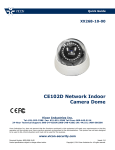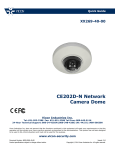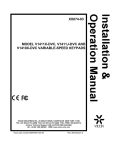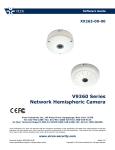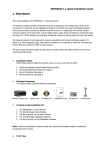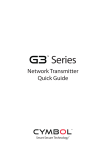Download Vicon VN-901T Product specifications
Transcript
Quick Guide XX267-20-00 VN-901T Single-Channel Video Encoder Vicon Industries Inc., 89 Arkay Drive, Hauppauge, New York 11788 Tel: 631-952-2288 Fax: 631-951-2288 Toll Free: 800-645-9116 24-Hour Technical Support: 800-34-VICON (800-348-4266) UK: 44/(0) 1489-566300 Vicon Industries Inc. does not warrant that the functions contained in this equipment will meet your requirements or that the operation will be entirely error free or perform precisely as described in the documentation. This system has not been designed to be used in life-critical situations and must not be used for this purpose. www.vicon-security.com Document Number: 8009-8267-20-00 Product specifications subject to change without notice. Issued: 613 Copyright © 2013 Vicon Industries Inc. All rights reserved. Quick Installation Guide 1. Description The information in this manual provides quick installation and setup procedures for the VN-901T Video Encoder. These units should only be installed by a qualified technician using approved materials in conformance with federal, state, and local codes. Read these instructions thoroughly before beginning an installation. Always refer to Vicon’s website to assure you have the most up-to-date manual, www.vicon-security.com. The VN-901T supports the network service for an existing analog camera. An analog image entered can be monitored on a real-time screen regardless of distances and locations. By using its dedicated program, many users are able to have access to the VN-901T Encoder at once or a single user can monitor various encoders at the same time. It also enables users to play, store and retrieve a monitoring image by using a PC. All the settings and real-time monitoring screens are also provided through access to the web. The VN-901T is fully compatible with all ViconNet® systems; its ONVIF certification provides an openplatform for integration into other video management systems. The encoder is equipped with an RS-485 port for connecting third party PTZ systems. The alarm input and alarm output can be used to connect various third party devices, such as door sensors and alarm bells. • Installation Steps Follow these steps to install the encoder on your local network (LAN): 1. 2. 3. 4. • Check the package contents against the list below. Connect the encoder. Set an IP address. Set the password. Package Component The system comes with the following components: Product Unit • Installation CD Quick Guide Mounting Bracket Mounting Screws Contents in the installation CD 1. The VN-901T User’s Manual 2. The SmartManager User’s Manual 3. The SmartManager Installation software Note: Make sure all these components have been received before starting installation. 2 Quick Installation Guide • Front View NO 1 2 3 4 • Function USB Reset Button Network Indicator Power Indicator Description Not used. Press this button to restore the factory default settings Lights when a remote user is connected to the unit. Lights when the power is on. Steady amber during booting and flashing amber during factory default. Steady green for normal operation and steady red for failed upgrade. Rear View NO 3 Function Power adaptor connector Network connector(PoE) 8-pin I/O terminal 4 Audio In/Out 5 Video In/Out 1 2 Description Connects a power adapter or an external power supply, 12V DC or 24V AC, max. 5W. RJ-45 port compatible with 10/100 Mbps (PoE function). Connects RS-485, alarm input and output. Connects the port to the microphone and speaker(amplifier function). Connects the video input and output. 3 Quick Installation Guide 2. Installation • Mounting The VN-901T Encoder is supplied with a mounting kit for wall mounting. The mounting bracket can be positioned for mounting the encoder on a vertical surface. • Connecting to the RJ-45 Connect a standard RJ-45 cable to the network port of the network encoder. Generally a cross-over cable is used for direct connection to a PC, while a direct cable is used for connection to a hub. • Connecting the Power Connect the 12 VDC or 24 VAC power adapter to the encoder. • Network Connection and IP Assignment The video encoder is designed for use on an Ethernet network and requires an IP address for access. Most networks today have a DHCP server that automatically assigns IP addresses to connected devices. By the factory default, your video encoder is set to obtain the IP address automatically via DHCP server. If your network does not have a DHCP server the network camera will use 192.168.1.100 as the default IP address. If DHCP is enabled and the product cannot be accessed, run the “Smart Manager” utility on the CD to search and allocate an IP address to your products, or reset the product to the factory default settings and then perform the installation again. 1. Connect the Video Encoder to the network and power up. 2. Start SmartManager utility (Start>All programs>SmartManager>SmartManager); the main window will be displayed. After a short time any network devices connected to the network will be displayed in the list. 3. Select the encoder on the list and click right button of the mouse. The pop-up menu displays as below. 4 Quick Installation Guide 4. Select Assign IP. The Assign IP window displays. Enter the required IP address. Note: For more information, refer to the Smart Manger User’s Manual. 5 Quick Installation Guide 3. Operation The Video Encoder can be used with Windows operating system and browsers. The recommended browsers are Internet Explorer®, Safari®, Firefox®, Opera® and Google® Chrome® with Windows. Note: To view streaming video in Microsoft® Internet Explorer, set your browser to allow ActiveX controls. Note: Some screens may appear different depending on the firmware version, but the functionality is the same or similar. 3.1 Access from a browser 1. 2. 3. Start a browser (i.e., Internet Explorer). Enter the IP address or host name of the encoder (the encoder name as it appears in the ViconNet site list) in the Location/Address field of your browser. A starting page displays. Click Live View or Setup to enter web page. 4. Click Live View for the Video Encoder’s Live View page appears in your browser. 6 Quick Installation Guide 3.2. Access from the internet Once connected, the Video Encoder is accessible on your local network (LAN). To access the Video Encoder from the Internet you must configure your broadband router to allow incoming data traffic to the Video Encoder. To do this, enable the NAT-traversal feature, which will attempt to automatically configure the router to allow access to the Video Encoder. This is enabled from Setup > System > Network > NAT. For more information, refer to “3.5.7 System>Network>NAT” of User’s Manual. 3.3 Setting the admin password over a secure connection To gain access to the product, the password for the default administrator user must be set. This is done in the “Admin Password” dialog, which is displayed when the Video Encoder is accessed for the setup at the first time. Enter your admin name and password, set by the administrator. Note: The default administrator username is “ADMIN” and password is “1234”. If the password is lost, the Video Encoder must be reset to the factory default settings. See “3.6 Resetting to the Factory Default Settings”. To prevent network eavesdropping when setting the admin password, this can be done via an encrypted HTTPS connection, which requires an HTTPS certificate (see note below). To set the password via an encrypted HTTPS connection, see “3.5.7 System >Security>HTTPS” of User’s Manual. Note: HTTPS (Hypertext Transfer Protocol over SSL) is a protocol used to encrypt the traffic between web browsers and servers. The HTTPS certificate controls the encrypted exchange of information. 3.4 Live View Page The live view page comes in several screen modes: 704x480(576), 640x480, 352x240(288) and 320x240. Select the most suitable mode. in accordance with your PC specifications and monitoring purposes. 7 Quick Installation Guide 1) General controls Live View Page Search & Playback Page Setup Page Help Page The video drop-down list allows you to select a customized or pre-programmed video stream on the live view page. Stream profiles are configured under Setup > Basic Configuration > Video & Image. For more information, see “3.5.1 Basic Configuration > Video & Image” of User’s Manual. The resolution drop-down list allows you to select the most suitable video resolutions to be displayed on live view page. The protocol drop-down list allows you to select which combination of protocols and methods to use depends on your viewing requirements and on the properties of your network. 2) Control toolbar The live viewer toolbar is available in the web browser page only. It displays the following buttons: The Stop button stops the video stream being played. Pressing the key again toggles the start and stop. The Start button connects to the encoder or start playing a video stream. The Pause button pauses the video stream being played. The Snapshot button takes a snapshot of the current image. The location where the image is saved can be specified. The Digital Zoom activates a zoom-in or zoom-out function for video image on the live screen. The Full Screen button causes the video image to fill the entire screen area. No other windows will be visible. Press the 'Esc' button on the computer keyboard to cancel full screen view. The Manual Trigger button activates a pop-up window to manually start or stop the event. The PTZ button activates a pop-up window for Pan, Tilt and Zoom control. Use the Speaker icon scale to control the volume of the speakers. Use the Microphone icon scale to control the volume of the microphone. Use the slider icon scale to control the volume of the speakers and microphones. 3) Pan/Tilt/Zoom Controls If the Video Encoder has been appropriately configured, the Live View page displays the controls available for the installed Pan/Tilt/Zoom (PTZ) device. The administrator can enable/disable the controls for specified users. For more information, see “3.6 PTZ Control” of User’s Manual. 8 Quick Installation Guide 4) Video Streams The Video Encoder provides several image and video stream formats. Your requirements and the properties of your network will determine the type you use. The Live View page in the Video Encoder provides access to H.264, MPEG-4 and Motion JPEG video streams and to the list of available video streams. Other applications and clients can also access these video streams/images directly, without going via the Live View page. 3.5 Video Encoder Setup This section describes how to configure the Video Encoder, and is intended for product Administrators, who have unrestricted access to all the Setup tools, and Operators, who have access to the settings for Basic, Live View, Video & Image, Event, and System Configuration. You can configure the Video Encoder by clicking Setup in the top right-hand corner of the Live View page. Click on this page to access the online help that explains the setup tools When accessing the Video Encoder for the first time, the “Admin Password” dialog appears. Enter your admin name and password, set by the administrator. Note: If the password is lost, the Video Encoder must be reset to the factory default settings. See “3.6 Resetting to the Factory Default Settings”. The default administrator username is “ADMIN” and password is “1234”. 3.6 Resetting to the factory default settings To reset the Video Encoder to the original factory settings, go to the Setup>System> Maintenance web page (described in “3.5.7 System > Maintenance”, the User’s Manual) or use the Reset button on the front panel of the Video Encoder. • Using the Reset Button Follow the instructions below to reset the Video Encoder to the factory default settings using the Reset button. 1. 2. 3. 4. 5. Switch off the Video Encoder by disconnecting the power adapter. Press and hold the Reset button with a small pointed object, such as a straightened paperclip, while reconnecting the power. Keep the Reset button pressed for at least 2 seconds. Release the Reset button and wait for the Status LED to turn off. The Video Encoder resets to factory defaults and restarts after completing the factory reset. The unit now has the default IP address 192.168.1.100 Caution: When performing a Factory Reset, any settings that have been saved will be lost. 9 Quick Installation Guide 3.7 More Information For more information, refer to the Video Encoder User’s Manual, which is available on the CD included in this package. 10 11 Vicon Industries Inc. For office locations, visit the website: www.vicon-security.com














